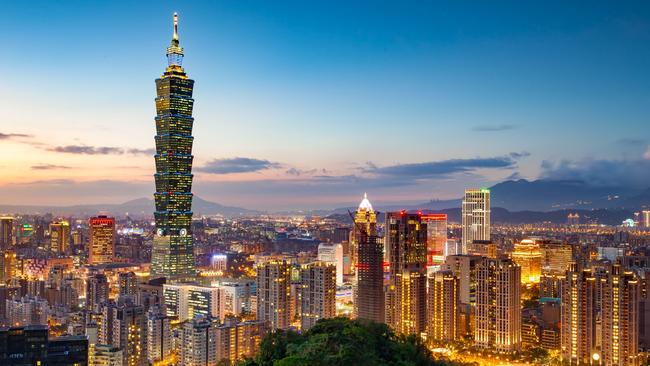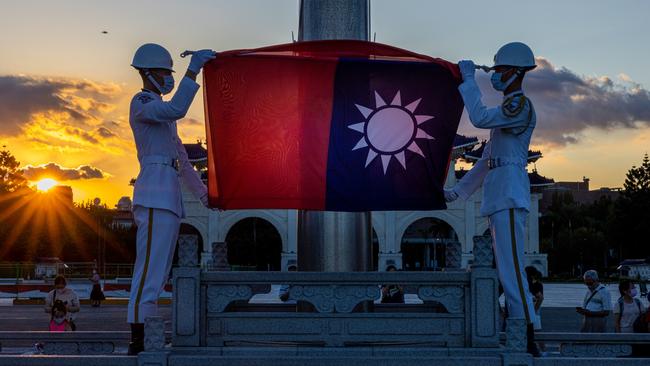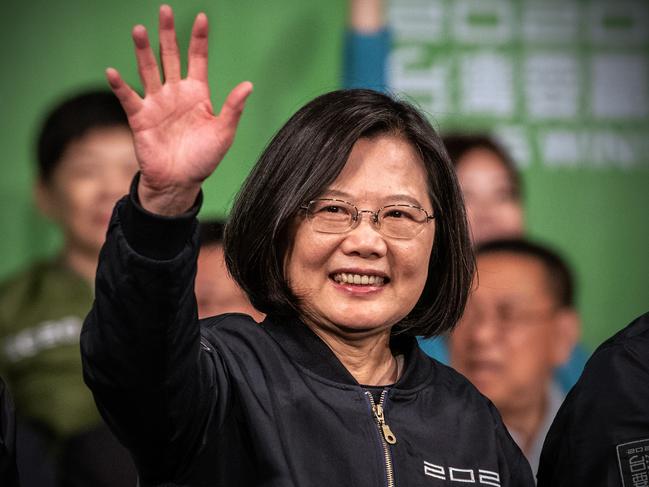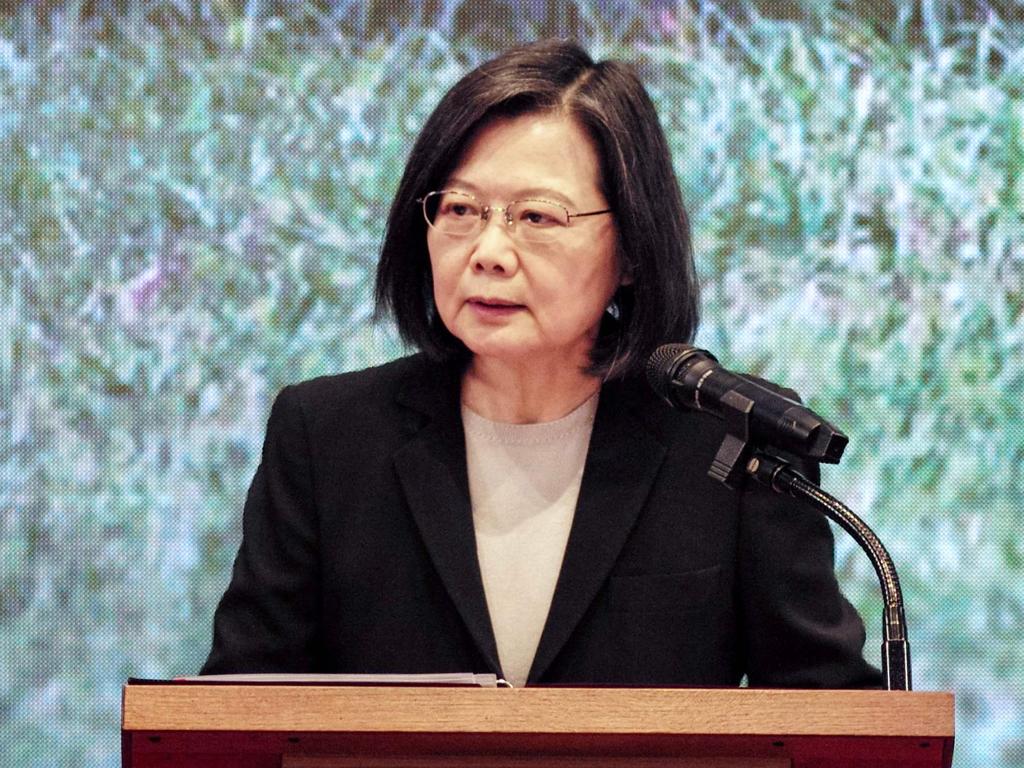Our friendship with Taiwan is tested in straitened times
Taiwan is Australia’s fifth-largest export market and represents an especially natural economic, social and cultural partner for Australia in the region. But how do we foster that relationship under Beijing’s watchful gaze?

New year, new China relationship. But what is it, what opportunities does it present, and what might it preclude? Might Australia’s promising range of relationships with Taiwan – now our fifth biggest export market – end up as collateral damage?
Australia and the People’s Republic of China are starting the new year eyeing themselves off cautiously but hopefully. Foreign Minister Penny Wong said after meeting PRC counterpart Wang Yi in Beijing recently that growing the relationship while upholding our national interests comprises “the challenge of this generation”.
Top Australian China expert John Fitzgerald describes the way this is shaping up as “the new Australia-China accord”.
Trade Minister Don Farrell told The Australian a couple of days ago that the government had informed Beijing it would rather resolve China’s moves against Australian wine and barley by discussion than by proceeding through World Trade Organisation actions, “on the basis that there’s some goodwill shown on both sides.”
A fresh arrangement is not only being sought by Australia. US Commerce Secretary Katherine Tai says Washington too needs “a new playbook on China that serves our interests”, one that will be opened when Secretary of State Anthony Blinken heads to Beijing early in the new year.
The challenge to start anew has been set up by the unchallengeable leader of the PRC, Chinese Communist Party general secretary Xi Jinping. The changing “ideological landscape” is his principal focus, summarised in his “Thought on Socialism with Chinese Characteristics for a New Era” that guides every aspect of PRC life today, at every level.
There can be no “re-set”, no “re-engagement”, no return to a supposed halcyon era of relationship with the PRC that started with Canberra’s diplomatic recognition 50 years ago. Under Xi, everything is new.
In his work report to the 20th party congress two months ago, which crucially set the agenda for China’s next five years, Xi said the party has presented “a series of new ideas, new thinking, and new strategies on national governance, and achieved a new breakthrough in adapting Marxism to … the needs of our times … There is no end to theoretical innovation.”
Xi described this breakthrough as requiring “an indomitable fighting spirit … an emphasis on political commitment in selecting and appointing officials … (becoming) actively involved in setting global security rules … strengthening party leadership in state-owned enterprises, and party building in non-public enterprises and in trade associations, academic societies and chambers of commerce”.
He continued: “We have forged ahead with resolve to carry out a great struggle with many new features of our times … in the new era,” thus achieving a “great transformation”.
These are not hollow or idle words. They set the pattern for the brave new Chinese world. Unlike his “best, most intimate friend” Vladimir Putin, whose ego is all, Xi is not only a creator but also a sincere creature of the party he leads.
Xi’s country is one with which all Australians have connections – through buying whitegoods, or owning savings in companies that sell commodities, or working alongside people born in China. Some Australians – this writer included – also love many aspects of Chinese cultures, though they are often quite different from the “China” deconstructed and then re-created by the CCP.
It is right to welcome the easier tone in the formal government-to-government relationship between Australia and the PRC since Labor was elected, and to have toasted the 50th anniversary of diplomatic ties.
But this is not the China of a decade or more ago, that seemed inexorably rising. It is a troubled China whose isolated leadership has made a series of blunders in managing the economy, Covid-19 and international relations.
And as the champagne glasses are stored away, it’s time to remind ourselves also of the continuing imposts levied by today’s Beijing party-state. These include the fact many Australian products are still unwelcome, that Australians Cheng Lei and Yang Hengjun remain political prisoners, and that we must be watchful about the PRC’s continuing ambitions.
In a politburo study session 18 months ago, Xi stressed the need to “form international discourse power that matches our comprehensive national power and international status”.
Tony Browne, a former New Zealand ambassador to China, has said in a manner that resonates here: “Our significance for China will continue to be primarily political rather than economic. No matter how important our trade is to New Zealand’s wellbeing, we will be judged in Beijing by what we say rather than what we sell.”
Leveraging favourable tone, or words, or the lack of them, is a high Beijing priority.
A further element at play in creating a new form of accord with the PRC is the potential gain from closer commercial, cultural and personal connections with Taiwan. Australia’s former resident – the equivalent of ambassador – in Taiwan, Kevin Magee, has correctly concluded in a paper for the Australian Centre on China in the World at the Australian National University, that “the Albanese government, aware of the sensitivity of the Taiwan issue for China, has sought to reduce tensions with China over Taiwan and to differentiate itself subtly from the US in its Taiwan policy”, with “the imperatives of the China relationship” taking precedence.
The PRC – including its Ministry of Foreign Affairs, which is still required to exude a “fighting spirit” in accord with Xi’s instructions, notwithstanding the more diplomatic tone of its communications in and with Australia – continues to press relentlessly, if somewhat more politely, on every issue. Thus Beijing recently complained, for instance, about Australia making its own defence arrangements with the US in the Northern Territory – “abandon the old Cold War zero-sum thinking and narrow geopolitical concepts”, instructed Foreign Ministry spokesman Zhao Lijian.
Zhao also attacked Canberra’s plans to boost its involvement in critical minerals mining and refining, saying “no one should use the economy as a political tool or weapon … or punch the existing world economic system”, apparently unselfconscious about China’s record of commercial coercion.
Inevitably, Beijing also complained about a half-dozen backbench MPs from the major parties recently visiting Taiwan, with Anthony Albanese explaining this was not a government delegation. The party-owned Global Times editorialised: “Considering Albanese’s vague and cop-out remarks which will undoubtedly encourage the arrogance of anti-China forces and pro-Taiwan secessionist forces in Australia, there is a big question mark hanging over Australia’s sincerity on improving its relations with China.”
The newspaper described politicians who visited Taiwan as “seeking limelight” and as resembling “political gods of plague and pestilence”.
This relentlessness prompts a desire for respite in Canberra, which understandably doesn’t wish to go back into the no-speak deep-freeze.
That’s natural, especially when meetings are often viewed almost as an end in themselves, with space being sought in which to puzzle through what shape a new Australia-China accord might take.
Among the many – the exhaustingly many – issues that always arouse PRC angst, it seems that, as Magee has suggested, Taiwan is perceived to present a suitable area for ceding such space. With only 13 diplomatic partners, it has scant capacity to press internationally and Taiwan support within Australia appears to lack the political clout or the ruthlessness to lobby sufficiently irritatingly to gain top-level attention.
Canberra’s attitude to Taiwan thus tends to remain constant, whichever party’s in power. If Australian relations with the PRC are fraught, Canberra says it’s not the appropriate time to do more with Taiwan, in case that makes Beijing even more mad. If Australia-PRC relations are good, it’s considered safest not to imperil that sweet spot by building better ties with Taiwan. If China relations are delicately balanced, don’t rock that boat. The official line thus amounts to: stay at a safe, disinterested distance.
It doesn’t have to be like that, though. The misreading that is common in Canberra and elsewhere is driven by the spotlight placed on Taiwan that focuses almost entirely on its political relationship with the PRC, on its putative fate as a victim of blockade or military attack.
This is deeply frustrating for the 24 million people of Taiwan, and also for those elsewhere who are interested in, supportive of or engaged with Taiwan on a personal, cultural or business basis.
Taiwan itself is scarcely deemed to have agency, with its governance, economy, society and culture largely unregarded. It is typecast as an object of conjecture in imagined strategic plays between the PRC and the US.
Our own Department of Foreign Affairs and Trade, in its online brief about Taiwan, starts with the establishment of the PRC in 1949 and notes that “under the constitution of the Republic of China, the authorities in Taipei still claim to be the legitimate government of the whole of China”.
This bewildering reference comes from the 1947 Kuomintang constitution, made by a party that then governed mainland China, and that founded in 1912 the Republic of China, to replace the foreign Manchu dynasty that ruled the country.
Its relevance to contemporary Taiwan is historic and by now obscure. Almost no one in Taiwan today – certainly not the Kuomintang – claims to rule “China”. Indeed, the number of Taiwanese people who now view themselves as “Chinese” works out as very similar to the number of Australian residents who view themselves as Chinese – about 4 per cent of the population.

University of Tasmania senior lecturer Mark Harrison has pointed out that “coherent, progressive anti-imperial struggle has been the normative national story of Taiwan since the 19th century”, one that runs parallel to the RoC narrative that derives from mainland China.
The DFAT brief continues, in a relentlessly negative tone: “The terms of our Joint Communique dictate the fundamental basis of Australia’s one China policy – the Australian government does not recognise the RoC as a sovereign state and does not regard the authorities in Taiwan as having the status of a national government. Dealings between Australian government officials and Taiwan, therefore, take place unofficially. For example, Australia’s representative office in Taiwan does not have diplomatic status nor do Taiwan’s representative offices in Australia.”
Such awkwardness – or absence – at the official level naturally informs informal and unofficial relations too, unease cascading down.
The joint communique mentioned in that DFAT brief, issued in Paris on December 21, 1972, by the ambassadors to France of Australia and the PRC, “acknowledges the position of the Chinese government that Taiwan is a province of the People’s Republic of China”.
Thus the PRC has its “one China principle” while we have our “one China policy” – although it’s unclear why Australia even needs to have one any more, except for Beijing’s own focus on the issue, which has grown steadily in intensity during these 50 years.
Australia and the PRC’s other diplomatic partners are expected to fall in line with this convoluted “one China” framing. In reality, Australia retains the capacity to develop for itself many varieties of relationship with Taiwan that do not require diplomatic recognition, although it remains a puzzle hard to explain to people of common sense how a population about the same as Australia’s, living within and policing clearly defined borders, possessing its own disciplined services, printing its own banknotes and electing its own leaders, must never be described as a country.
Yet Taiwan represents an especially natural economic, social and cultural partner of Australia in the region. It was one of four Asian Tigers that led the path to rapid prosperity and modernisation. It has remained on that course. Since relaxing its fairly strict – not by comparison with Victoria, though – and comparatively successful Covid policy, it is again open to travel.
It has succeeded in attracting substantial investment back home by its world-class tech companies led by TSMC, which produce more than 60 per cent of the global output of semiconductors. Most Apple products are made by Taiwanese company Foxconn. About 1000 factories have relocated back to Taiwan from the PRC in recent years.
Taiwan’s gross domestic product growth has twice exceeded, twice underperformed, the PRC’s in the past four years, and this is likely to continue, as it will for Australia. Taiwan’s citizens – poorer than most mainlanders when the CCP came to power there – are now on average about five times wealthier than those in China, with 45 per cent of those aged 25 to 64 holding a bachelor’s degree or higher.
Taiwan is becoming Australia’s fifth-largest export market, and for the month of October moved to fourth, behind only China, Japan and South Korea.
Australian investment in Taiwan has reached $20bn, including Macquarie in two offshore wind farms, and Taiwan’s in Australia, $15bn, including Formosa Steel in the Fortescue-led Iron Bridge project. Nine Taiwanese banks operate here, more than from any other overseas source.
Taiwan-Australian economic relations can help point to a transformed future, for instance in the deal recently struck between Taiwan battery company Aleees and Australian Securities Exchange-listed lithium miner Avenira, to develop a battery manufacturing plant in Darwin.
Treasurer Jim Chalmers wrote in The Australian that “while Australia supplies about 55 per cent of the world’s lithium, we only have a very small part of the processing industry … This is where our great opportunity lies – in moving our way up and along the value chain.”
A few weeks ago, 50 delegates from Taiwan flew to Sydney for the first joint business conference for three years – due to Covid – with the Australia-Taiwan Business Council. The key themes were energy transitions, green finance, education and recycling. The energy in the room was intensified by 24 innovative three-minute presentations on these themes by emerging business leaders – almost all of them under 30 years old – from Australia and Taiwan. The Taiwan delegates also spent a day in Wollongong investigating hydrogen production facilities.
Within Australia’s top 10 export partners, Canberra lacks a free-trade agreement with Taiwan alone. The growing need to diversify supply chains in East Asia requires intensifying connections with rule-of-law jurisdictions that abound in strong business prospects, in which Taiwan looms large.
As we emerge into a post-lockdown era, many economic and geo-strategic settings are changing. Engaging in talks towards a free-trade agreement with Taiwan, a few years after Taiwan FTAs were concluded by New Zealand and Singapore, would help bed down the recent surge in trade, and send a positive signal to the two business communities about partnering.
Australia might also consider supporting Japan’s backing for Taiwan’s application for the Comprehensive and Progressive agreement for Trans Pacific Partnership, the CPTPP. And Trade Minister Farrell said that if China dropped its Australian trade bans, this would send a positive message about Beijing’s free trade commitment to CPTPP member economies, which have yet to decide on applications from both Taiwan and the PRC.
We can build closer Taiwan relations through our Indigenous peoples, with Wong soon to appoint a First Nations ambassador. Most of the peoples of the Pacific Islands can trace their original journeyings via Taiwan, backed up by DNA, linguistic, artistic and other evidence.
Taiwan has a ministry-level Council of Indigenous Peoples whose aims include strengthening relations between Taiwan’s indigenous groups and those in other countries.
Mutual tourism – including visiting the greatest museum in Asia, the National Palace Museum in Taipei – studying, and teaching language skills are promising areas for expansion.
But potential travellers would be highly confused by the Qantas website, which urges tourists to “book all-inclusive flights to Taiwan, China” – a puzzling destination to anyone not immersed in the political history of our region.
Taiwan has become a model liberal democracy, government switching between parties three times since elections began 30 years ago.
Its period of stable government under Tsai Ing-wen – its centre-left Democratic Progressive Party president for almost seven years, socially progressive, economically liberal and cautious internationally, where her key initiative has been her New Southbound Policy focusing efforts on Southeast Asia and India – is coming to an end. She can’t serve beyond early 2024, when there will be presidential and parliamentary elections.

Whoever succeeds her is almost certain to maintain the status quo on cross-strait relations.
The liveliness and the stability of Taiwan’s democracy were on show at recent local government elections, where the Kuomintang, the centre-right opposition, won control of 13 of 22 cities and counties, triggering the resignation of Tsai as chair of her party though she remains Taiwan’s President. Intriguingly, Chiang Wan-an, great-grandson of Taiwan’s longtime leader, Chiang Kai-shek, now becomes mayor of Taipei.
No serving Australian federal minister has visited there since Labor’s trade minister Craig Emerson, 10 years ago. Yet other countries send ministers regularly – such as Britain’s Trade Minister Greg Hands, who flew there in November for talks.
Canberra naturally continues to acknowledge Beijing’s position about Taiwan, while retaining the capacity to develop for itself many varieties of relationship with the island.
It should do more to teach Australian sub-federal governments and other institutions such as universities, as well as the business world, that profitable connections can be developed with Taiwanese counterparts without triggering consequential diplomatic alarm bells.
Albanese has said: “We will co-operate with China where we can, but we will stand up for Australian values where we must”, and earlier he complained that federal election campaigning had been reduced “to sound bites rather than philosophies and values”.
Casting around the region, few places so clearly share as many public-life values with Australia as Taiwan. But this has led to few meaningful formal links beyond Queensland.
Besides five Queensland sister-city arrangements, and a formal Perth-Taipei relationship, the sole Taiwan sister city in Australia comprises Marrickville, in Albanese’s constituency, with Keeling. Yet there are 59 Australian sister relationships with PRC entities.
Taiwanese people are not complacent about the threat from the PRC, but it is one they have learned to live with for 73 years, during which time the status quo has held, and which they overwhelmingly want to maintain.
Australia needs now to develop a new workaday Australia-China accord that provides the respectful space everyone needs. Australians can also benefit greatly from deeper and more diverse relations with Taiwan and Taiwanese people, as part of creating our own new era.
Rowan Callick is an industry fellow at Griffith University’s Asia Institute and a board member of the Australia Taiwan Business Council.




To join the conversation, please log in. Don't have an account? Register
Join the conversation, you are commenting as Logout